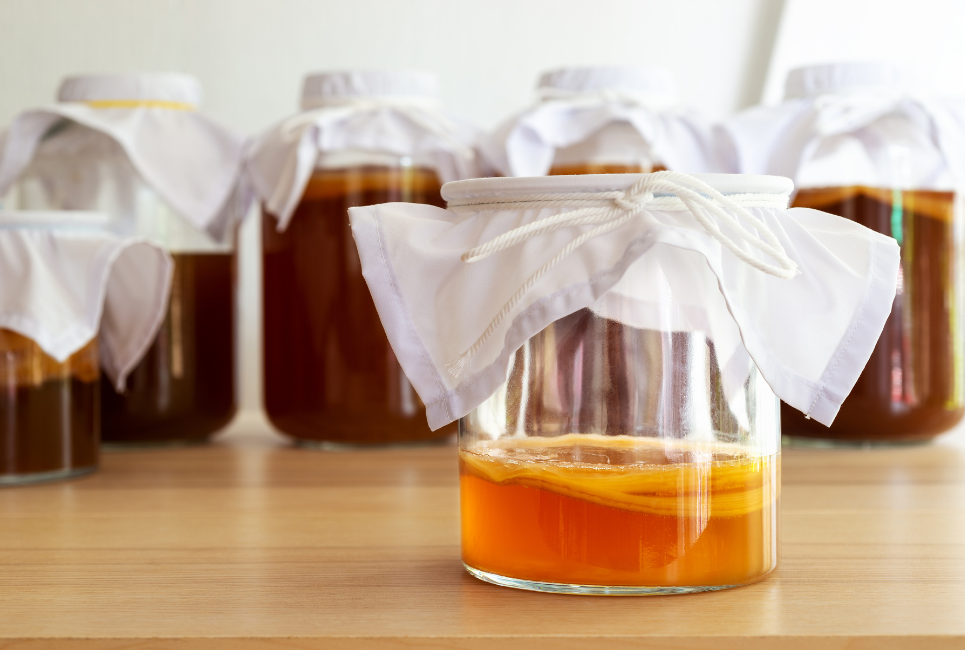Have you ever brewed Kombucha and had your SCOBY (the colony of bacteria and yeast that ferments the sweet tea) sink to the bottom of the jar or container? Don’t worry; you’re not alone. It’s a relatively common occurrence.
These are questions to confuse a lot of Kombucha lovers and makers alike. But why does it happen, and is there anything you can do about it?
A SCOBY that sinks can still produce high-quality Kombucha. However, you should do a few things if your SCOBY starts sinking. Keep reading to find more answers to these questions that confuse most people.
What Is A Kombucha SCOBY?
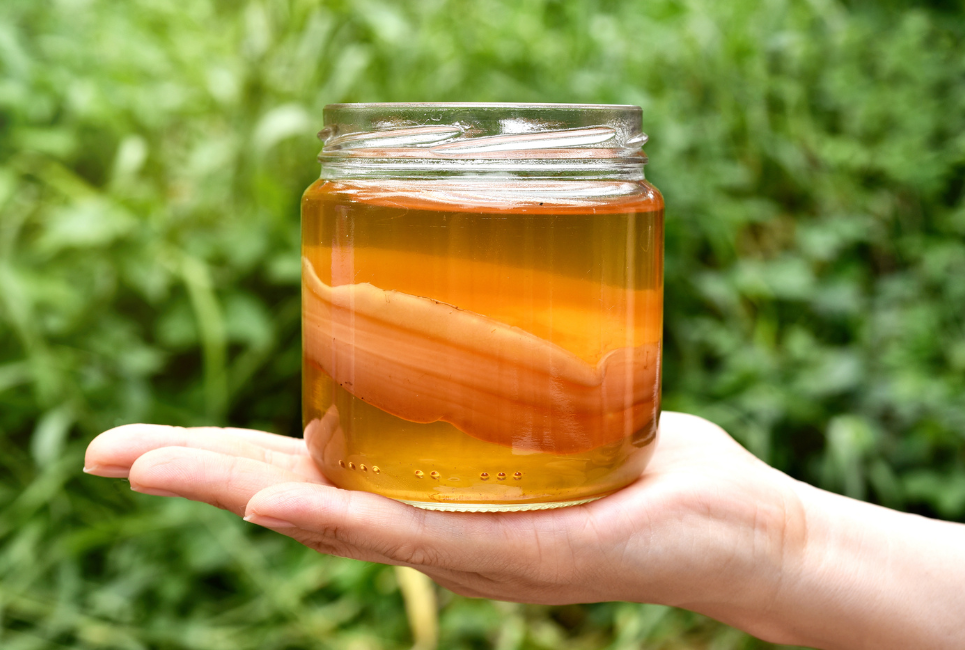
A kombucha SCOBY is a symbiotic colony of bacteria and yeast that forms during the fermentation process of Kombucha.
“SCOBY ” is an acronym for Symbiotic Culture Of Bacteria and Yeast. This live culture contains beneficial Acetobacter bacteria, which convert the alcohols produced by the yeast into organic acids.
These organic acids give Kombucha its tangy flavor and are responsible for its probiotic properties.
Kombucha SCOBY s are often compared to “mothers” or “starters” used in other types of fermentation, such as sourdough bread or kimchi.
Unlike these mothers, however, kombucha SCOBYs are not reused indefinitely. Instead, once a Kombucha has been brewed, the SCOBY is removed, and a new one is added to a fresh sweet tea to start the next batch of Kombucha.
Kombucha SCOBYs are available for purchase online or from some health food stores. They can also be made at home, although this requires access to a continuous culture of Kombucha (also known as a “mother”).
Health Benefits Of Kombucha Tea
Kombucha is a fermented tea with many health benefits, including aiding digestion, boosting energy levels, and helping detoxify the body.
The fermented beverage is made by adding a symbiotic colony of bacteria and yeast (also known as a SCOBY ) to sweetened tea.
This colony ferments the sugars in the tea, which creates ethanol and acetic acid. The final product is a slightly sour, slightly fizzy drink rich in probiotics.
There are many purported health benefits of Kombucha, but most haven’t been backed up by science. That said, there are some promising studies on the potential health effects of Kombucha.
For example, one study found that Kombucha may help protect against liver damage, while another showed that it might help improve cholesterol levels.
If you’re interested in trying Kombucha, remember that it contains a small amount of alcohol (about 0.5% by volume).
Therefore, it’s inappropriate for everyone, including pregnant women and young children. Additionally, purchase Kombucha from a reputable source to reduce your risk of food poisoning.
To sum up, Kombucha is a fermented tea containing probiotics that may have some health benefits. However, more research is needed to confirm these potential effects.
Should A Kombucha SCOBY Float Or Sink?
Most people think that if a SCOBY floats, it signifies good health and fermentation. And if it sinks, it is a sign of bad health or fermentation.
The truth is that both floating and sinkings are signs of good and lousy kombucha fermentation, respectively.
A healthy SCOBY will float because of the air pockets within the matrix of cells. However, an unhealthy or old SCOBY will sink because the cells will have filled with CO2 and be heavier than water. So both floating and sinking are signs that your Kombucha is fermenting correctly.
How Does Kombucha SCOBY Sink?
The sinking of a SCOBY has nothing to do with the health and safety of your brew, but rather it’s due in part to forces that are out-of-our control.
The most common cause for this is, Physics! When you drop an immersed SCOBY into a new batch of Kombucha, chances are high it’ll end up below surface level – not afloat as expected (and desired).
This may happen because the weight from above causes them to dive deeper than usual, making their shape change.
What Makes Kombucha SCOBY Sink?
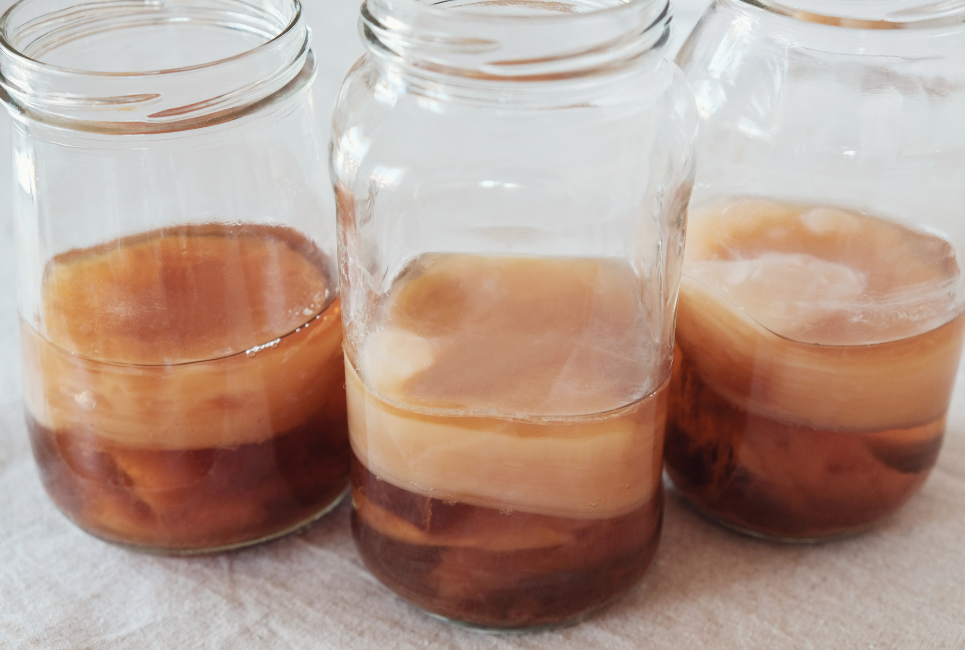
Kombucha is an excellent source of bacteria and yeast, which can contribute to its flavor. But the reason why your SCOBY might have sunk in recent times isn’t that something’s wrong with your brew–it has everything do so instead!
When new tea leaves enter the kombucha fermentation process, they add weight above what was there before due to rising bubbles that push down on them; this force cause owes both elevating gas pressure and consolidating liquid foam onto surfaces below.
The ideal temperature for fermenting Kombucha is around 75-85F. If the room temperature drops below this range, less active yeast will cause it to sink in the middle of the cycle;
however, healthy cultures can still produce plenty of CO2 without any problems even if there’s a slower fermentation speed because they generate more energy through sugar consumption than what was inputted by ingredients like tea or black Bulgarian wine you might have used!
A couple of questions might come to mind when the SCOBY sinks:
Is The SCOBY Unhealthy?
However, if you see any of the following symptoms on your SCOBY, then it might be time to get yourself some new ones:
- Foul-smelling fizzer or moldy taste in the mouth.
- Shrinking size over several weeks’ worth of brews.
Though the Kombucha SCOBY is 99% healthy, it can sometimes take on all shapes and forms.
Is The SCOBY Rotten?
You can tell if your Kombucha SCOBY is doing well by testing it! To make a typical recipe, add the baby bacteria to some sweet tea.
Wait one week and observe whether any of these signs appear: new bubbles forming on its surface or bigger ones than before; more gunk growing out from under them like hair (this may mean that you have gone too far); less sweetness in both flavor and acidity level–that’s what happens when everything starts turning into vinegar…
When you make unsupervised Kombucha, it’s always best to keep an eye on the color of your drink. If they develop unusual strains of mold that turn green or gray, this could be a sign there has been some problem with temperature fluctuations between batches which would lead us to think one thing–that our SCOBY s were weak!
Or maybe even too low for how long we left them at room temperatures before brewing again?
It might also cause no carbonation because these yeast/bacteria combinations don’t work well when everything needs more time than usual (like 6+ hours).
The presence of black or brown streaks on a SCOBY means that it has already died and begun decomposing.
These colors come from a pigment in tea leaves, which can also lead to an unpleasant smell if prominent enough, so you should always be sure not to drink any brew with these indicating signs!
Variables Affecting SCOBY Sinking Or Floating

Kombucha SCOBY sinking or floating is affected by numerous variables, including the type of tea used, the sugar content, the fermentation time, the temperature, and even the vessel’s orientation. Here’s a more detailed look at each of these factors:
- Type of tea: The tea you use can affect whether your SCOBY sinks or floats. Black teas produce floaters, while green teas usually result in sinkers. Some people believe using herbal teas will create a floater, but this has not been scientifically proven.
- Sugar content: The amount in your kombucha recipe can also influence whether your SCOBY sinks or floats. Generally, the more sugar you use, the more likely your SCOBY will float.
- Fermentation time: The longer your fermentation time, the more likely your SCOBY will sink. This is because as the kombucha ferments, the yeast and bacteria consume the sugars, resulting in a denser mixture.
- Temperature: The temperature of your Kombucha can also affect whether your SCOBY sinks or floats. Warmer temperatures produce floaters, while cooler temperatures usually result in sinkers.
- Orientation of vessel: The orientation of your fermentation vessel can also influence whether your SCOBY sinks or floats. If you ferment your Kombucha in a horizontal vessel, your SCOBY is more likely to float. If you ferment your Kombucha in a vertical vessel, your SCOBY is more likely to sink.
As you can see, there are a variety of factors that can influence whether your Kombucha SCOBY sinks or floats. In general, black tea, sugar content, longer fermentation times, warmer temperatures, and horizontal vessels will produce floaters.
Green teas, lower sugar content, shorter fermentation times, cooler temperatures, and vertical vessels usually result in sinkers. However, it’s important to remember that these are just general trends – your SCOBY may still float even if you use green tea or ferment it for a shorter time.
Ultimately, it’s up to you to experiment with different kombucha recipes and find the one that produces the SCOBY behavior you prefer.
Is It Normal For SCOBY To Sink To The Bottom?
It’s perfectly normal for a Kombucha SCOBY to sink to the bottom of the fermentation vessel. So if your Kombucha SCOBY is floating, it’s probably because it’s not getting enough oxygen.
Oxygen is necessary for the bacteria and yeast in the Kombucha SCOBY to break down the sugar into alcohol and carbon dioxide.
The best way to ensure that your Kombucha SCOBY gets enough oxygen is to aerate it regularly. You can do this by stirring it with a clean spoon or refining it through a strainer.
Should I Push My SCOBY Down?
Whether you should push your SCOBY down when it floats or up when it sinks depends on your goal. For example, if you’re trying to make a thicker, less bubbly kombucha, pushing it down will help reduce some of the carbon dioxides.
However, pushing it up will help aerate it and promote carbon dioxide production if you’re trying to make a thinner, more effervescent kombucha. Ultimately, it’s up to you and your preference!
What To Do If The SCOBY Sinks?
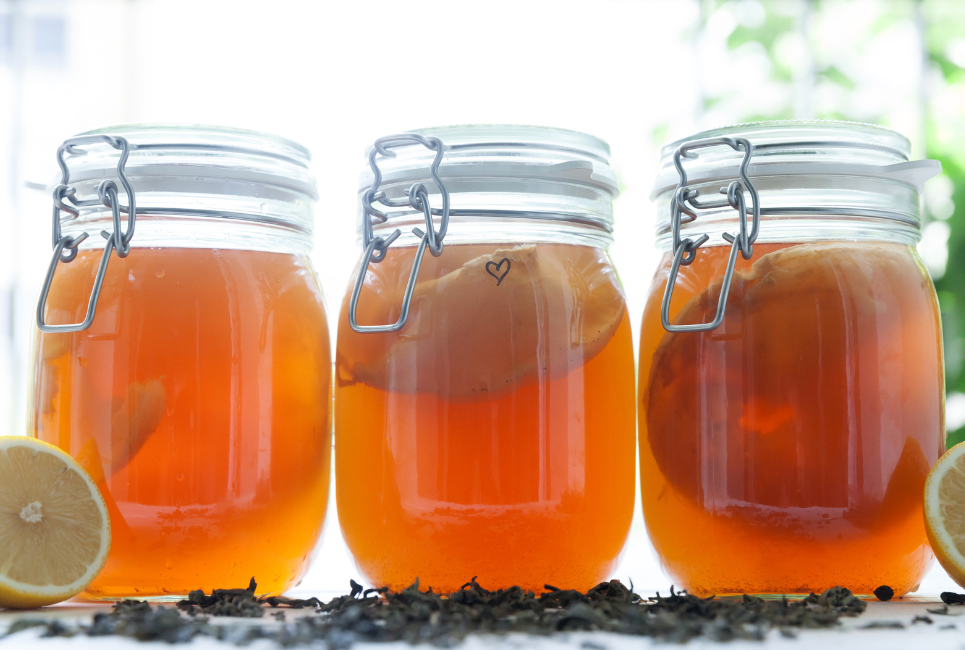
If you find that your Kombucha SCOBY is sinking, there are a few things you can do to remedy the situation. First, make sure that you’re using fresh, unfiltered water.
Second, add a bit more sugar to the fermentation vessel. Third, ensure the room temperature is between 68 and 85 degrees Fahrenheit. Lastly, aerate the Kombucha SCOBY regularly by stirring it or passing it through a strainer.
You can do a couple of things if your Kombucha SCOBY sinks. One is to gently pour most of the starter liquid out of the kombucha tea before adding fresh sweet tea.
This will help lighten the SCOBY, giving it a better chance of floating. You could also try scooping the SCOBY out with a spoon and then dropping it back into the tea. Of course, if nothing seems to be working, you can always start over with a new SCOBY.
- The water you’re using is too cold.
- There isn’t enough sugar in the brew.
- The pH of the brew is off.
- There are too many beneficial bacteria in the brew (this one is less likely).
If your SCOBY is sinking, you’ll need to take action to fix the issue. The first thing you should do is check the temperature of your brew. It should be between 68-85 degrees Fahrenheit. If it’s not, adjust the temperature and check on your SCOBY.
Next, you’ll want to ensure enough sugar in the brew. Kombucha needs sugar to feed the SCOBY and help it float. If there isn’t enough sugar, the SCOBY will sink. To fix this, add more sugar to the brew.
If the temperature and sugar levels are excellent, then the pH is next to check. Kombucha should have a pH between 4.5 and 5.5. If the pH is off, it can cause the SCOBY to sink. You can adjust the pH with an acid or base to fix this.
The last thing to check is the number of beneficial bacteria in the brew. Too many beneficial bacteria can crowd out the SCOBY and cause it to sink. To fix this, you can add more sugar to the brew.
If you’ve checked all these things and your SCOBY is still sinking, it’s time to start with a new SCOBY. Sometimes, a SCOBY doesn’t have what it takes to float. If that’s the case, don’t worry – plenty of other SCOBY s out there will be happy to take their place.
If you follow these tips, your Kombucha SCOBY should start floating again in no time!
The Crucial Effect Of Bacteria And Yeast
The crucial effect of bacteria and yeast making a Kombucha SCOBY sinks is that it produces the tea’s signature sour flavor.
When you first start brewing Kombucha, the SCOBY will be very thin and almost translucent. Then, as the kombucha ferments, it will become thicker and more opaque. The final stage of fermentation is when you get that distinctively sour taste.
At this point, most of the sugar has been eaten up by the bacteria and yeast, and what’s left is mostly vinegar.
Why Do Some People Think It Is A Bad Sign When The SCOBY Sinks?
Some think it is not normal for Kombucha SCOBY to sink to the bottom. It’s a big red flag that something is wrong with the Kombucha. If the SCOBY is sinking, it’s not getting the support it needs to float correctly.
The SCOBY position in the jar is not a big deal after all
It doesn’t matter if the SCOBYs sink or float; what matters is if the fermenting kombucha process is done correctly.
it’s safe to say that many people overthink the importance of the SCOBY’s position in the jar. 😉
Here’s why it isn’t a big deal:
- First, it’s important to remember that the SCOBY is a living organism. Just like any other living thing, it will adapt and adjust to its environment. So, if you move the SCOBY from one spot to another in the jar, it will simply find a new spot to settle into.
- Second, even if the SCOBY doesn’t move after being moved, that’s okay! It will continue to do its job of fermenting your Kombucha.
So, don’t worry about the SCOBY’s position in the jar. Just let it do its thing and enjoy drinking Kombucha.
How To Avoid SCOBY Sinking When You Start Making Kombucha?
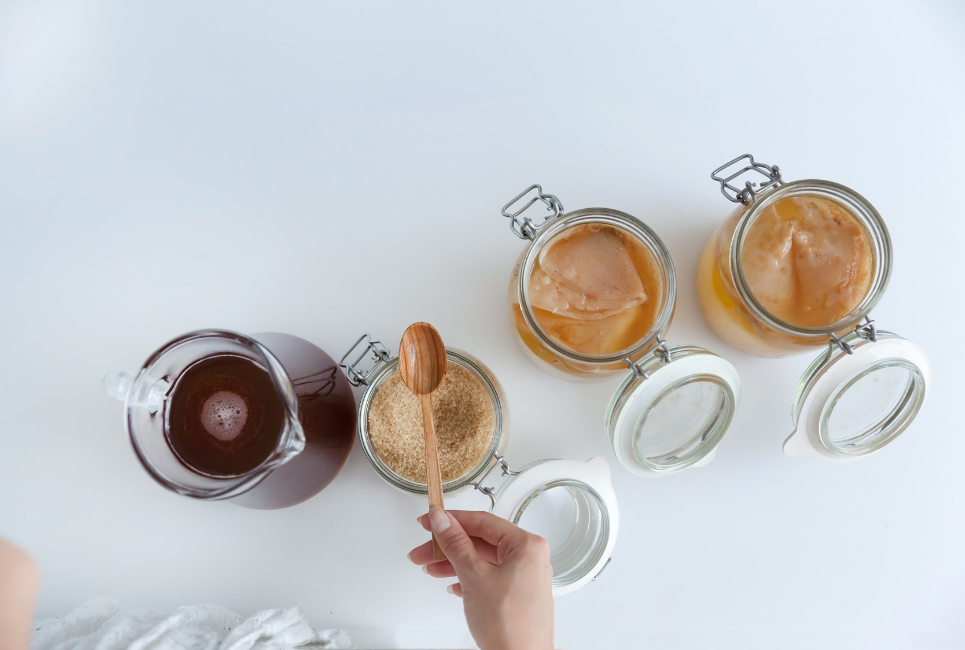
The SCOBY sinking is a common issue that many beer brewers face. However, there are a few things that you can do to avoid this problem.
- Keep your fermentation vessel clean and free of debris.
- Make sure that the temperature of your fermenting Kombucha is between 68-72 degrees Fahrenheit.
- Avoid using too much fruit or juice in your kombucha recipe, as this can cause the SCOBY to sink.
- Use a high-quality, organic green tea for brewing kombucha, as this will provide the best environment for the SCOBY to thrive.
- Be patient and give your kombucha plenty of time to ferment correctly before bottling or consuming it. Following these tips should help to keep your SCOBY from sinking!
Make sure your container is large enough. The more surface area your SCOBY has, the less likely it is to sink. And finally, you can add some of the already fermented Kombucha to your new batch. This will help give your SCOBY extra buoyancy and keep it from sinking.
If you want to ensure your starter culture continues happily growing, don’t move it too much. If left alone throughout fermentation, they’ll grow across the top after 7-21 days!
The bottom line
So, is it normal for SCOBY to sink to the bottom? The answer is a resounding yes! There are many reasons your SCOBY might drop below the kombucha tea mixture, and most of them are nothing to worry about.

